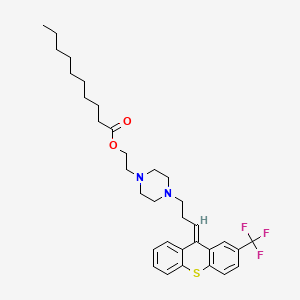



1. Depixol
2. Flupenthixol Decanoate
3. Flupenthixol Decanoate, (z)-isomer
1. Flupenthixol Decanoate
2. 30909-51-4
3. Flupentixol Decanoate, (e)-
4. 55irh67u29
5. 201213-08-3
6. Decanoic Acid, 2-(4-((3e)-3-(2-(trifluoromethyl)-9h-thioxanthen-9-ylidene)propyl)-1-piperazinyl)ethyl Ester
7. Decanoic Acid, 2-(4-(3-(2-(trifluoromethyl)-9h-thioxanthen-9-ylidene)propyl)-1-piperazinyl)ethyl Ester, (e)-
8. Einecs 250-385-6
9. Unii-3b2fe28c1w
10. (e)-flupentixol Decanoate
11. 2-(4-(3-(2-trifluoromethyl-9-thioxanthenylidene)propyl)-1-piper Azinyl)ethyl Decanoate
12. Unii-55irh67u29
13. 3b2fe28c1w
14. Dtxsid10897160
15. Akos015961763
16. 2-(4-(3-(2-(trifluoromethyl)-9h-thioxanthen-9-ylidene)propyl)-1-piperazinyl)ethyl Decanoate
17. 2-[4-[(3e)-3-[2-(trifluoromethyl)thioxanthen-9-ylidene]propyl]piperazin-1-yl]ethyl Decanoate
18. Ncgc00532514-01
19. Ac-15023
20. Q27896316
| Molecular Weight | 588.8 g/mol |
|---|---|
| Molecular Formula | C33H43F3N2O2S |
| XLogP3 | 9.2 |
| Hydrogen Bond Donor Count | 0 |
| Hydrogen Bond Acceptor Count | 8 |
| Rotatable Bond Count | 15 |
| Exact Mass | 588.29973428 g/mol |
| Monoisotopic Mass | 588.29973428 g/mol |
| Topological Polar Surface Area | 58.1 Ų |
| Heavy Atom Count | 41 |
| Formal Charge | 0 |
| Complexity | 815 |
| Isotope Atom Count | 0 |
| Defined Atom Stereocenter Count | 0 |
| Undefined Atom Stereocenter Count | 0 |
| Defined Bond Stereocenter Count | 1 |
| Undefined Bond Stereocenter Count | 0 |
| Covalently Bonded Unit Count | 1 |
Dopamine Antagonists
Drugs that bind to but do not activate DOPAMINE RECEPTORS, thereby blocking the actions of dopamine or exogenous agonists. Many drugs used in the treatment of psychotic disorders (ANTIPSYCHOTIC AGENTS) are dopamine antagonists, although their therapeutic effects may be due to long-term adjustments of the brain rather than to the acute effects of blocking dopamine receptors. Dopamine antagonists have been used for several other clinical purposes including as ANTIEMETICS, in the treatment of Tourette syndrome, and for hiccup. Dopamine receptor blockade is associated with NEUROLEPTIC MALIGNANT SYNDROME. (See all compounds classified as Dopamine Antagonists.)
Tranquilizing Agents
A traditional grouping of drugs said to have a soothing or calming effect on mood, thought, or behavior. Included here are the ANTI-ANXIETY AGENTS (minor tranquilizers), ANTIMANIC AGENTS, and the ANTIPSYCHOTIC AGENTS (major tranquilizers). These drugs act by different mechanisms and are used for different therapeutic purposes. (See all compounds classified as Tranquilizing Agents.)
